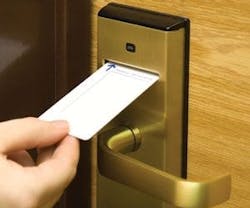The Basics of Security Door Hardware
Routinely, a building’s doors are thought of as the main security deterrent. While doors are a major factor, they’re only part of a well-designed security system. A door system includes the frame, the door, hinges, the door handle, the closure, and the locking mechanism. A lock system is basically designed to prevent unauthorized entry or exit to or from a specific area. The system, which consists of design, manufacture, installation, and maintenance, must be designed for effectiveness and ease of operation.
Locks and keys are basic elements of a security system. Mechanical locks are designed so that tumblers won’t function unless properly aligned. The pin tumbler is the most common system used by architects and builders. Keys are easily replaced when lost, and are easily copied. Restricted keyways are available through most key manufacturers, but be mindful of expiring patents. Door locks can be picked or circumvented relatively easily if someone is experienced with locking mechanisms. Other types of locks include deadbolt, mortise, rim mounted, tubular, cylindrical, or padlock.
Many institutions have evolved to electronic systems. A card-style system’s information is entered electronically, prohibiting or controlling access to specific areas, or controlling times of access. The information can be easily changed if the cards are lost or stolen. Cards can be issued on a temporary basis, and they automatically time out.
Various card styles include:
- Hollerith cards, which are used in hotels. The card is inserted, and the lock disengages after matching registration information.
- Magnetic stripe cards, which have a data-encoded stripe on one face that matches previously entered criteria. These cards can hold much information, but are subject to damage.
- Proximity cards, which include embedded microcircuits that emit frequencies detectable by a reader within 2 to 4 inches.
- Smart cards, which are the cards of the future. They contain their own processor, and they can store large amounts of data.
- Biometric cards, which corroborate claimed identities on the basis of some unique biometric characteristic of the individual, including fingerprints, handprints, eye pattern, handwriting, voice, face, and vein identification (the newest).
- Magnetic switches, which are magnetic and switch units combined to detect opening and closing doors.
Door closures are important to determine how long a door is to remain open. There are two types. A manual type is adjusted to determine how long the door stays open. An automatic opener is controlled by push button, motion detector, or other device, and closes automatically when it is safe to close.
Door hardware is often overlooked. The door hinge in secure areas should have non-removable pins installed with a hardened set screw. The hinges should have 3-inch screws that screw into the studs of the doorframe. Guard plates may be recommended in areas to reduce tampering with the locking mechanism.
It’s important to remember that a secure door system consists of a combination of mechanical and electronic locking devices. Your vulnerability is determined by your weakest link.
Dan Finger is a physical security consultant at Daniel R. Finger LLC, located in Jacksonville, FL.
